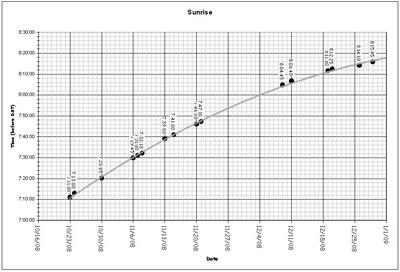Solstice turns out to be real
(Stuff That I'm Messing With) Permanent Link made 11:13 AM | TrackBacks (0)
Comments (4) Make a Comment
Just realized/was shocked that this means you wake up before sunrise.
Posted by: Sam at December 30, 2008 12:16 AM
I do wake up before sunrise (gasp!)
And I think that table does mesh with my data. My sunrise times won't be the same because I don't have a clean horizon. I'm timing the sunrise over Bonita Canyon. The trend, though, is consistent. Coffee notwithstanding.
In your data the sunrise continues to get later even after 12/21. Same with my data. Before this experiment I would have thought that on 12/21 the sunrise would start getting earlier and sunset later. That isn't the case in my data, or the data that you posted.
Posted by: Don at December 30, 2008 10:26 AM
From a private response from an Astronomy Professor at UCI Irvine:
"I can give you a shortish answer and maybe explain it better the next time we run into each other. It has to do with the fact that clocks are set using mean solar time (the time it would be if the earth's axis wasn't tilted with respect to its orbit around the sun, and if the orbit were perfectly circular).
The 23.5 degree tilt and the fact that the orbit isn't quite circular both work to make local high-noon later than a clock's noon in the early winter. This shifts both sunrise and sunset later relative to the clock (note that without this effect, sunrise will become later and sunset will become earlier, as you might originally think). This systematic shift in both sunrise and sunset messes up your expectation that they should expand uniformly around clock noon.
Why does this happen? Before solstice the sun is moving slightly slower to the east than it would if the earth weren't tilted. After solstice, it goes the other way.
"
So I read this as: the earths orbit is not round and clocks assume that it is.
Posted by: Don at December 31, 2008 12:14 PM
Just realized/was shocked that this means you wake up before sunrise.
Posted by: Sam at December 30, 2008 12:16 AMI do wake up before sunrise (gasp!)
And I think that table does mesh with my data. My sunrise times won't be the same because I don't have a clean horizon. I'm timing the sunrise over Bonita Canyon. The trend, though, is consistent. Coffee notwithstanding.
In your data the sunrise continues to get later even after 12/21. Same with my data. Before this experiment I would have thought that on 12/21 the sunrise would start getting earlier and sunset later. That isn't the case in my data, or the data that you posted.
Posted by: Don at December 30, 2008 10:26 AMFrom a private response from an Astronomy Professor at UCI Irvine:
"I can give you a shortish answer and maybe explain it better the next time we run into each other. It has to do with the fact that clocks are set using mean solar time (the time it would be if the earth's axis wasn't tilted with respect to its orbit around the sun, and if the orbit were perfectly circular).
The 23.5 degree tilt and the fact that the orbit isn't quite circular both work to make local high-noon later than a clock's noon in the early winter. This shifts both sunrise and sunset later relative to the clock (note that without this effect, sunrise will become later and sunset will become earlier, as you might originally think). This systematic shift in both sunrise and sunset messes up your expectation that they should expand uniformly around clock noon.
Why does this happen? Before solstice the sun is moving slightly slower to the east than it would if the earth weren't tilted. After solstice, it goes the other way.
"
So I read this as: the earths orbit is not round and clocks assume that it is.
Posted by: Don at December 31, 2008 12:14 PM
*gets comment party started*
Irvine, CA-specific data from http://is.gd/e9hN corroborates the traditional story. Posted at http://samkaufman.net/suntimes.html . How, exactly, doesn't it mesh with your data? Also, methods?
Running hypothesis: you perceive light differently, pre-morning coffee.
Posted by: Sam at December 30, 2008 12:09 AM